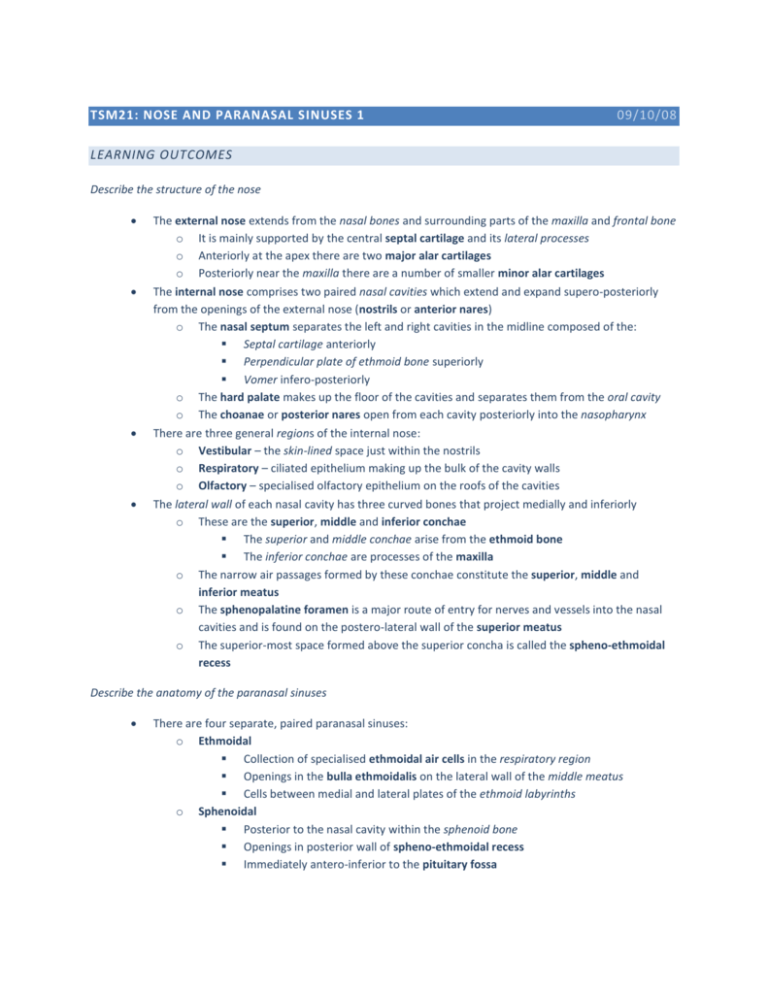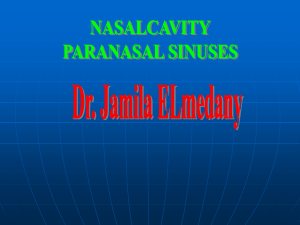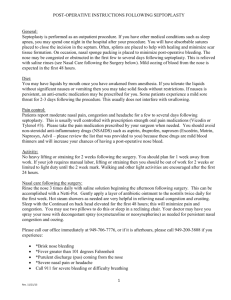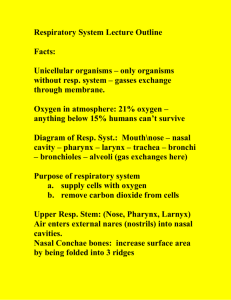TSM21: nose and paranasal sinuses 1 09/10/08
advertisement

TSM21: NOSE AND PARANASAL SINUSES 1 09/10/08 LEARNING OUTCOMES Describe the structure of the nose The external nose extends from the nasal bones and surrounding parts of the maxilla and frontal bone o It is mainly supported by the central septal cartilage and its lateral processes o Anteriorly at the apex there are two major alar cartilages o Posteriorly near the maxilla there are a number of smaller minor alar cartilages The internal nose comprises two paired nasal cavities which extend and expand supero-posteriorly from the openings of the external nose (nostrils or anterior nares) o The nasal septum separates the left and right cavities in the midline composed of the: Septal cartilage anteriorly Perpendicular plate of ethmoid bone superiorly Vomer infero-posteriorly o The hard palate makes up the floor of the cavities and separates them from the oral cavity o The choanae or posterior nares open from each cavity posteriorly into the nasopharynx There are three general regions of the internal nose: o Vestibular – the skin-lined space just within the nostrils o Respiratory – ciliated epithelium making up the bulk of the cavity walls o Olfactory – specialised olfactory epithelium on the roofs of the cavities The lateral wall of each nasal cavity has three curved bones that project medially and inferiorly o These are the superior, middle and inferior conchae The superior and middle conchae arise from the ethmoid bone The inferior conchae are processes of the maxilla o The narrow air passages formed by these conchae constitute the superior, middle and inferior meatus o The sphenopalatine foramen is a major route of entry for nerves and vessels into the nasal cavities and is found on the postero-lateral wall of the superior meatus o The superior-most space formed above the superior concha is called the spheno-ethmoidal recess Describe the anatomy of the paranasal sinuses There are four separate, paired paranasal sinuses: o Ethmoidal Collection of specialised ethmoidal air cells in the respiratory region Openings in the bulla ethmoidalis on the lateral wall of the middle meatus Cells between medial and lateral plates of the ethmoid labyrinths o Sphenoidal Posterior to the nasal cavity within the sphenoid bone Openings in posterior wall of spheno-ethmoidal recess Immediately antero-inferior to the pituitary fossa o Maxillary – the largest of the sinuses Beyond the lateral walls of the nasal cavity within the maxillae Openings in the hiatus semilunaris floor on the lateral wall of the middle meatus Drain at the apex – prone to filling with fluids that are then difficult to drain o Frontal Superior to the nasal cavities within the frontal bone Openings in the hiatus semilunaris ‘roof’ on the lateral wall of the middle meatus Drains through the frontonasal duct to the ethmoidal infundibulum The nasolacrimal duct carries tears from the corner of the eye and opens in the inferior meatus infero-anterior to the hiatus semilunaris Describe the blood supply of the nose The nasal cavities are supplied by various branches of the internal and external carotid arteries: o Sphenopalatine artery Terminal branch of maxillary artery – branch of external carotid Enters the nasal cavity through the sphenopalatine foramen Gives lateral branches supplying most of the lateral wall Gives septal branches supplying most of the medial wall o Greater palatine artery Branch of maxillary artery – branch of external carotid Enters the anterior floor of the nasal cavity through the incisive canal Supplies the anterior septum and floor Anastomoses with septal branches of the sphenopalatine artery o Anterior and posterior ethmoidal arteries Both branches of the ophthalmic artery – branch of internal carotid Both descend into the nasal cavity through the cribriform plate Both give lateral and septal branches Anterior division has anastomoses with branches of the sphenopalatine artery and terminates as the external nasal artery supplying skin of the external nose Posterior division supplies the upper lateral and medial walls Describe the nerve supply of the nose General sensory innervation to the nose is through the ophthalmic and maxillary divisions of the trigeminal cranial nerve –and V2 respectively o Ophthalmic nerve (V1) gives two key branches, the ethmoidal nerves: Anterior branch travels with the anterior ethmoidal artery and supplies the anterior medial and lateral walls before terminating as the external nasal nerve Posterior branch supplies the ethmoidal air cells and does not enter the nasal cavity o Maxillary nerve (V2) gives various branches, the majority of which pass through the sphenopalatine foramen: Lateral branches supply the lateral wall Nasopalatine nerve supplies the medial wall before terminating in the oral mucosa The associated mucous glands are innervated by parasympathetic fibres of the facial nerve o Post-ganglionic fibres arise from the pterygopalatine ganglion and run with V2 fibres










